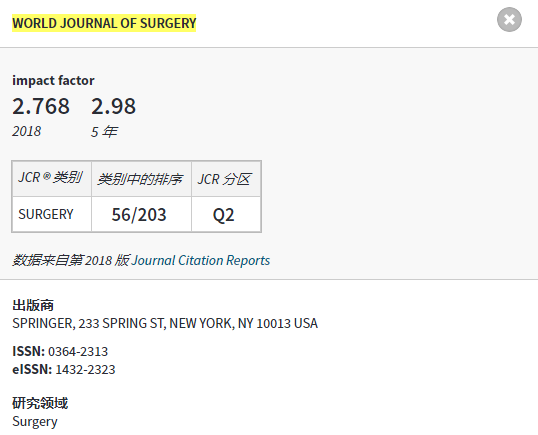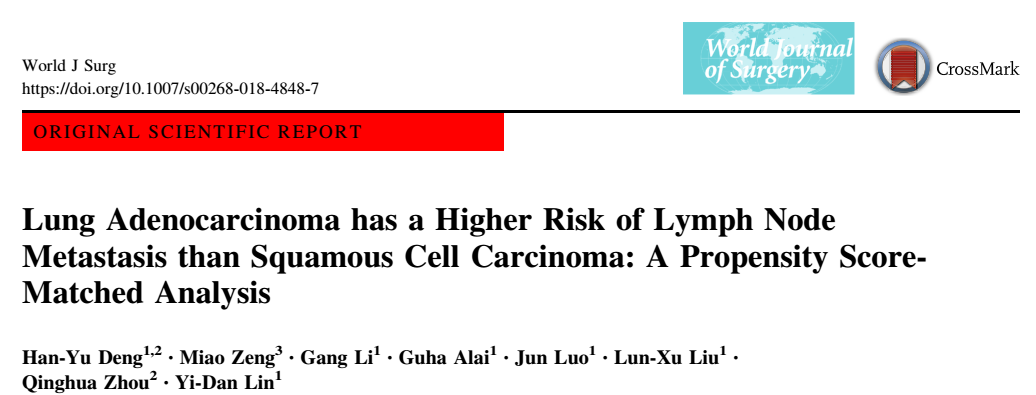健康知识库
- 当前位置: > 外科 >
肺腺癌、肺鳞癌----究竟哪种病理类型的患者更容易发生淋巴结转移?----来自四川大学华西医院的研究
编辑:ddayh.cn
- 上一篇:上腹部不舒服怎么办?
- 下一篇:早期非小细胞肺癌的最佳治疗选择
- 200肠息肉变肠癌需要多久?95%肠癌
- 200胆囊切除术后的饮食调整
- 200浅谈先天性心脏病治疗的误区(一
- 200麦默通的适应症和禁忌症
- 200新冠肺炎三阶段
- 200癌从口入!7个最"招癌"
- 200冠心病,风心病,薄膜病,以及先
- 200肺大疱的鉴别诊断
- 200自发性气胸综述
- 200动脉导管未闭的时机和手术方式
- 200胸壁结核的临床表现
- 200浅谈女性尿路感染
- 200肛门坠胀原因分析
- 200硬膜下积液
- 200同位素肾图
- 200正确的哺乳方式
- 200步行器使用技巧,你掌握了多少?
- 200脑出血的前兆是什么
- 200尿血?!癌症?!
- 200预防低温烫伤——如何使用电暖宝
肺癌已成为全球癌症发病率最高和癌症相关死亡的最主要原因,其中非小细胞肺癌占所有肺癌的约85%,而鳞状细胞癌和腺癌是其中两种最主要的组织学类型。据报道,肺鳞癌和腺癌具有不同的分子生物学起源以及不同的预后[1,2]。考虑到淋巴结转移的状态仍然是非小细胞肺癌预后不良的重要预测指标[3],而目前肺腺癌与肺鳞癌患者都作为非小细胞肺癌接受相同的外科手术治疗[4],因此探讨这两种主要的非小细胞肺癌组织学亚型中淋巴结转移的不同趋势,对于二者淋巴结清扫方式的选择具有重要的参考价值。关于肺鳞癌与腺癌之间淋巴结转移的不同趋势的比较,以往的文献报道得出了相互矛盾的结论。一些研究发现肺腺癌的转移率高于肺鳞癌[5-7]。然而,恰好相反的是,一些研究又报道肺鳞癌比腺癌更有可能发生淋巴结转移[2,8]。此外,也有其他研究甚至认为肺鳞癌和腺癌的淋巴结转移倾向没明显差异[9-12]。考虑到非小细胞肺癌中淋巴结转移的情况与肿瘤大小、位置和分化程度等特点显著相关[13],因此有理由认为上述矛盾的结论可能是由于这些不平衡的混杂因素造成的。因此,在本研究中,本研究的目标是应用倾向得分匹配(propensity-score matched analysis,PSM)分析方法来比较关于肺鳞癌和腺癌之间淋巴结转移的不同模式,该分析通常用于分析观察性研究中的因果推断,通过平衡组间潜在的混杂因素来减少可能的偏倚[14],进而得出相对客观的结论。本研究应用这种方法比较肺腺癌患者和肺鳞癌患者淋巴结转移的规律,旨在为这两种主要亚型提供不同的淋巴结清扫策略提供证据。
本研究通过PSM分析比较了肺鳞癌和腺癌之间淋巴结转移不同的规律。本研究回顾性分析了接受肺叶切除术或肺段切除术加SLND的患者,同时所有的患者均为未行术前新辅助治疗的肺鳞癌或腺癌患者。本研究用于分析的数据包括年龄,性别,肿瘤大小,肺叶特异性肿瘤位置,肿瘤位置(周围型或中央型)和病理结果。本研究进行了PSM分析方法,以消除可能的混杂因素导致的潜在偏倚效应。最终,本研究纳入了387例患者(包括63例鳞癌患者和324例腺癌患者)进行分析。本研究证实了:
1.在对未匹配的两组队列的分析中,本研究发现鳞癌组和腺癌组之间没有足够的证据表明二者的阳性淋巴结数量(P=0.90)和淋巴结转移率(P=0.23)存在着显著的差异。此外,也没有足够的证据表明两组之间N1和N2淋巴结转移情况存在显著的不同。
2.?在匹配后的队列的分析中,本研究发现腺癌患者比鳞癌患者具有明显更多的阳性淋巴结数(P=0.008)和更高的淋巴结转移率(P=0.016)。此外,腺癌患者比鳞癌患者具有更多的阳性N1(P=0.021)和N2 淋巴结数(P=0.009)以及更高的N1(P=0.013)和N2 淋巴结转移率(P=0.006)。
结? 论:(1)肺腺癌比鳞癌更可能发生肺内、肺门及纵隔淋巴结转移,(2)不同病理类型的早期非小细胞肺癌应该采取不同的淋巴结清扫策略。
我们的研究发表在世界外科杂志(world journal of surgery, IF:2.7),得到了国际同行的高度认可!--肺癌的精准外科治疗,我们一直在努力:四川大学华西医院肺癌中心!


参考文献:
1.?? Herbst RS, Heymach JV, Lippman SM. Lung cancer. N Engl J Med, 2008, 359(13): 1367-1380.
2. ??Kawase A, Yoshida J, Ishii G, et al. Differences between squamous cell carcinoma and adenocarcinoma of the lung: are adenocarcinoma and squamous cell carcinoma prognostically equal? Jpn J Clin Oncol, 2012, 42(3): 189-195.
3. ??Asamura H, Chansky K, Crowley J, et al. The International Association for the Study of Lung Cancer Lung Cancer Staging Project: Proposals for the Revision of the N Descriptors in the Forthcoming 8th Edition of the TNM Classification for Lung Cancer. J Thorac Oncol, 2015, 10(12): 1675-1684.
4. ??Goldstraw P, Chansky K, Crowley J, et al. The IASLC Lung Cancer Staging Project: Proposals for Revision of the TNM Stage Groupings in the Forthcoming (Eighth) Edition of the TNM Classification for Lung Cancer. J Thorac Oncol, 2016, 11(1): 39-51.
5. ??Oda M, Watanabe Y, Shimizu J, et al. Extent of mediastinal node metastasis in clinical stage I non-small-cell lung cancer: the role of systematic nodal dissection. Lung Cancer, 1998, 22(1): 23-30.
6. ??Funakoshi Y, Maeda H, Takeda S, et al. Tumor histology affects the accuracy of clinical evaluative staging in primary lung cancer. Lung Cancer, 2010, 70(2): 195-199.
7.?? Saeteng S, Tantraworasin A, Euathrongchit J, et al. Nodal involvement pattern in resectable lung cancer according to tumor location. Cancer Manag Res, 2012, 4: 151-158.
8. ??Zhang YK, Chai ZD, Tan LL, et al. Association of lymph node involvement with the prognosis of pathological T1 invasive non-small cell lung cancer. World J Surg Oncol, 2017, 15(1): 64.
9. ??Asamura H, Nakayama H, Kondo H, et al. Lymph node involvement, recurrence, and prognosis in resected small, peripheral, non-small-cell lung carcinomas: are these carcinomas candidates for video-assisted lobectomy? J Thorac Cardiovasc Surg, 1996, 111(6): 1125-1134.
10. ?Takamochi K, Nagai K, Suzuki K, et al. Clinical predictors of N2 disease in non-small cell lung cancer. Chest, 2000, 117(6): 1577-1582.
11. ?Konaka C, Ikeda N, Hiyoshi T, et al. Peripheral non-small cell lung cancers 2.0 cm or less in diameter: proposed criteria for limited pulmonary resection based upon clinicopathological presentation. Lung Cancer, 1998, 21(3): 185-191.
12. ?Veeramachaneni NK, Battafarano RJ, Meyers BF, et al. Risk factors for occult nodal metastasis in clinical T1N0 lung cancer: a negative impact on survival. Eur J Cardiothorac Surg, 2008, 33(3): 466-469.
13. ?Farjah F, Lou F, Sima C, et al. A prediction model for pathologic N2 disease in lung cancer patients with a negative mediastinum by positron emission tomography. J Thorac Oncol, 2013, 8(9): 1170-1180.
14. ?Deng HY, Wang ZQ, Wang YC, et al. Oesophageal adenocarcinoma has a higher risk of lymph node metastasis than squamous cell carcinoma: a propensity score-matched study. Eur J Cardiothorac Surg, 2017, 52(5): 958-962.
热门外科